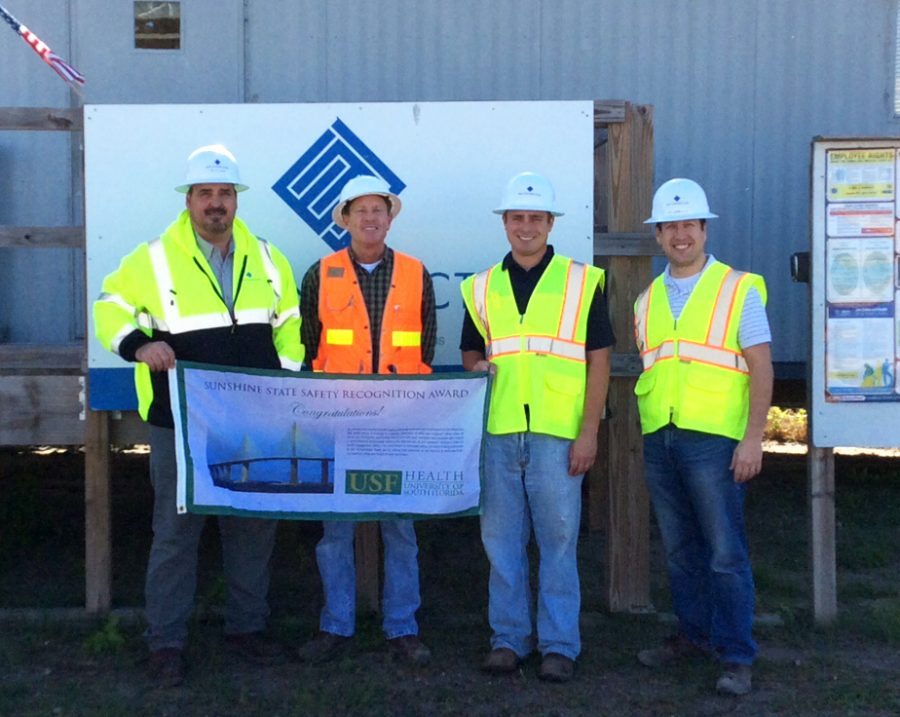
Superintendent Monroe Landell (left) and Level II Superintendent Chase Hirth (second from right) are paired in EMJ’s Builder’s Academy.
Engineering News-Record recently reported that 18% of construction supervisors will retire within the next five years. With the construction industry facing a labor shortage, EMJ launched a series of professional growth programs in 2016, under its Career-4-Life initiative to prepare the next generation of construction industry leaders.
Among these programs is career mapping, a formal mentoring program, and EMJ Builder’s Academy—a program developed to train and grow the individuals that oversee EMJ’s construction sites each and every day, our superintendents. Through the Builder’s Academy, less experienced on-site superintendents are paired with more experienced superintendents who share the wisdom and knowledge that only years of service can bring.
The superintendent teams, consisting of a Coach/Trainer (CT) and a Builder in Development (BID), utilize learning modules on Construct U, EMJ’s customized, online learning platform, while building a trusted, coaching relationship.
However, in the midst of a bustling construction site, there are obvious challenges to maintaining a program of this nature, such as time, organization and teamwork. Let’s be honest—mentoring doesn’t come naturally to everyone.
EMJ Superintendent Monroe Landell currently serves as a CT to Level II Superintendent Chase Hirth, and their relationship serves as an example of the value that Builder’s Academy can provide. They sat down with us to share advice for superintendents who are beginning the program.
Finding Time
The first step is to find time for development, which can be difficult.
“Finding time is honestly one of my biggest struggles,” says Chase. Not two that easily back down from a challenge, Chase and Monroe worked together to find time for Builder’s Academy. Below are some of their solutions.
Take 30 minutes. Take a lunch break, pull up a course, shut the door and watch a video. Break the longer two-hour courses into digestible chunks. “Understandably you’re going to have interruptions,” says Chase. “Do what you have to do. Pause the video and pick it back up when you get the chance. Whether it’s later that day or the next.”
Maximize the time you have. If you have down time on your current job or a break between one project completion and ground breaking on the next, use that time to make head way on the modules.
Make learning a habit. “Like daily reports and first work inspection, you make the time. Set a routine appointment, and stick with it,” says Monroe.
Organization
The second step is getting organized, which can be difficult if it’s something new and unfamiliar.
“The first time I looked at one of the Builder’s Academy modules and its 20 study courses and 17 execute courses, it was very overwhelming,” said Chase. “I instantly felt like I couldn’t do it.” Determined to succeed, Chase developed a system to help him get organized.
Print out a physical copy. “I take every execute course in a module and print the cover and follow up page,” said Chase. The cover page contains the tasks to be completed in the field and the follow up page holds the questions to verify the when, where and how of your tasks, which is signed off by the CT upon completion.
Get a folder or binder just for Builder’s Academy. This folder can become a place for notes, completed tasks and professional growth plans. According to Chase, having a central place to keep these things will make them more urgent and tangible.
Create a conversation. Having a central place where all completed tasks are recorded assists CTs in knowing what to go over with a BID and assists them in their coaching. “I take the time to fill out the execute task and then go over it with Monroe,” says Chase. “Sometimes he’ll look at it and say, ‘looks good, but did you remember to do turn downs’ or ‘have you tried looking at it like this?’” This conversation helps Chase prepare to log his work back into Construct U for records and reference later in the program.
Relationship Building
It’s not always easy to work with other people, much less take advice from them. So how do you form a healthy coaching relationship? What are the benefits of having a coach?
Research the other participant. Get to know the other person’s background, their work experience, and tap into that expertise. “Monroe was a Site Superintendent before this job,” said Chase. “So just from the ‘site’ aspect, he’s taught me about grading, rough grading and final grading.”
Coaching is a give and take. While Builder’s Academy is about teaching the BID, it doesn’t mean that the relationship is one-sided. Both the CT and BID are actively engaged in growing.
“Having someone I’m mentoring makes me want to step up and learn more so that I’ll have something to teach,” said Monroe.
Don’t be bull headed. It can be hard to take advice and suggestions from other people. “Being a Level II Superintendent, there can be a lot of criticism from more experienced Superintendents,” says Chase. “It’s not always easy to hear the truth. Still a lot of these people have gone through the same problems or situations that I’ve faced or will face. They understand the consequences of doing things wrong, because they’ve already done it.”
For more information on the EMJ Builder’s Academy, contact Jonathan Horne, and learn more about a career at EMJ here.
